Josef Blösche
Josef Blösche (12 February 1912 – 29 July 1969) was a member of the Nazi Party who served in the SS and SD during World War II. Blösche shot and killed many Jews, and sent many more Jews to their deaths in extermination camps.
Josef Blösche | |
|---|---|
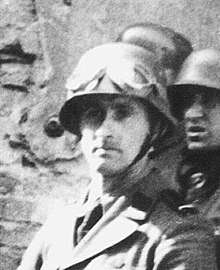 Blösche as he appeared in A Jewish boy surrenders in Warsaw | |
| Born | 12 February 1912 Friedland in Böhmen, Austria-Hungary |
| Died | 29 July 1969 (aged 57) |
| Known for | Murdering Jews |
| Criminal penalty | Death penalty |
| SS career | |
| Allegiance | |
| Service/ | |
| Years of service | 1938–1945 |
| Rank | Rottenführer |
| Unit | Sicherheitsdienst |
Blösche became known to the world because he was photographed with SS forces that suppressed the Warsaw Ghetto Uprising, as published in the Stroop Report. The photo portrays a little boy surrendering in the foreground, and Blösche as the SS man who is facing the boy with a sub-machine gun in hand. The Report was used in prosecution of former Nazis for war crimes. For his war crimes, Blösche was convicted and sentenced to death; he was executed in Leipzig on 29 July 1969.
Career
Blösche was born in Frýdlant, Czechoslovakia, then a part of the Austrian Empire. This was in the northern part of Bohemia very near the borders of Germany and Poland. His parents were ethnic Germans: his father, Gustav Blösche, owned a farm and a gasthaus (country inn).[1] Josef began to work on the farm and at the inn while going to school, but his father pulled him out of school at the age of 14 to work full time.[2]
Blösche participated in right-wing youth organizations promoting Nazi causes,[3] and he joined the Sudeten German Party, a pro-Nazi group advocating German expansion. In 1938, he joined the Nazi Party and the SS after Germany annexed the Sudetenland.[2] Blösche, who had previously volunteered for local SS, was drafted by the Waffen-SS on 4 December 1939 and reported to training the following day at Pretzsch Castle. He completed his training on 14 March 1940 and was assigned to Warsaw. He was shortly assigned to patrolling 6 miles (9.7 km) of the Bug River.[4]
After serving in Warsaw with the SS, he joined the Sicherheitsdienst (SD; Security Service), a division of the SS. In 1941, he was briefly transferred to the Eastern Front, where he served with the Einsatzgruppen mobile death squads. He participated in executions in the occupied parts of the Soviet Union, before being transferred back to Warsaw. He served in the SD's Warsaw ghetto outpost in mid-1942, when the mass deportation of Jews from there to the Treblinka extermination camp began. Blösche hunted down many Jews who were hiding from deportation. In January 1943, during another wave of deportations to the death camps, he took part in another search, which also involved frequent murders or executions. He participated in the shooting of about 1,000 Jews in 1943.[5]
The Jews gave him the nickname "Frankenstein", after a fictional monster, for his brutality, including the raping and killing of women in the ghetto.[2][6] Together with other SS members, he would go on expeditions in the ghetto and shoot random Jews to terrorize the residents. He participated in the suppression of the Warsaw Ghetto Uprising, and received the German War Merit Cross for his actions during the uprising. He later took part in the suppression of the Warsaw Uprising.[2]
In May 1945, he surrendered to the Red Army and became a prisoner of war of the Soviet Union. Blösche was sent to a camp administered by GUPVI (Main Administration for Affairs of Prisoners of War and Internees). In early 1946, he was repatriated to the Ostrava Region in Czechoslovakia, still as an internee. In August 1946 while working at a coal mine, he was struck by a descending hoist and suffered a fractured skull and serious facial injuries. He was hospitalised in Ostrava.
In 1947, his labour camp was dissolved, and Blösche was released to freedom. His facial scars protected him from discovery as one of the SS troops that were pictured in the official photos taken by Germans of the Warsaw ghetto. He moved to Urbach in Thuringia, Germany, to began living a normal life.[2] There, he met a German woman named Hanna Schönstedt, a mother and war widow, and they had two children together before she agreed to marry him.[7] He became a master tradesman at a potash works in Menteroda.[3]
Trial and conviction
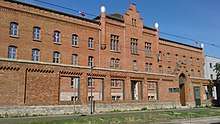
In 1961, a former SS acquaintance who was on trial in Hamburg linked Blösche to the atrocities he had committed in Warsaw. Blösche was eventually found in Urbach, where he was arrested by the Stasi on 11 January 1967.[8] He was detained in Hohenschönhausen Prison in Berlin.[9] He was put on trial in Erfurt in April 1969, and convicted of crimes against humanity. Witnesses at the trial described him as a callous sadist.[8]
During the trial, the Judge asked Blösche about the events depicted in the infamous photograph of the Warsaw Ghetto boy:
Judge: "You were with a submachine gun...against a small boy that you extracted from a building with his hands raised. How did those inhabitants react in those moments?"
Blösche: "They were in enormous dread."
Judge: "This reflects well in that little boy. What did you think?"
Blösche: "We witnessed scenes like these daily. We could not even think."[10]
Blösche was sentenced to death and executed in Leipzig on 29 July 1969 by firing squad.[11]
Gallery: Warsaw Ghetto Uprising
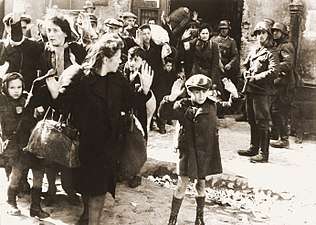
The infamous Warsaw Ghetto boy photograph from the Stroop Report (Blösche with submachine gun on the right). 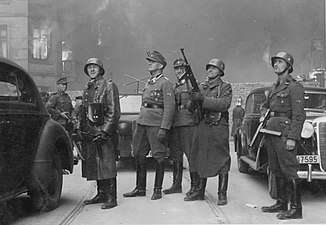
Blösche at right, with Jürgen Stroop at center watching housing blocks burn during the Warsaw Ghetto Uprising. Picture taken at Nowolipie street looking East, near intersection with Smocza street. On the left burning balcony of the townhouse Nowolipie 66. 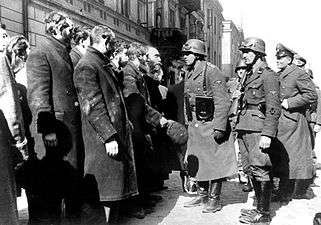
Photo from Nowolipie Street. In the back (from the left) are townhouses at Nowolipie 32 (fragment), 30 and 28.[12] Second from right is Josef Blösche. Similar picture, Stroop Report original caption: "Jewish Rabbis." 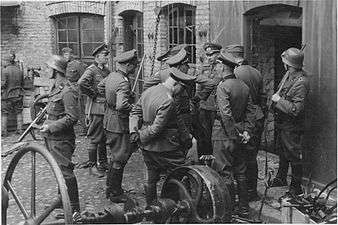
Stroop Report, showing Blösche at left. Original caption "Die Räumung eines Betriebes wird besprochen" {The clearance of a factory is being discussed}.
Citations
- Porat 2010, p. 31.
- "Josef Blösche". Holocaust Historical Society. 2018. Retrieved 6 June 2020.
- Fulbrook, Mary (2018). Reckonings: Legacies of Nazi Persecution and the Quest for Justice. Oxford University Press. pp. 326–328. ISBN 9780190681265.
- Porat 2010, pp. 50–51.
- "The Boy in the Photo?". holocaustresearchproject.org.
- Gmyz, Cezary (22 April 2007). "Seksualne niewolnice III Rzeszy" (in Polish). Wprost.
- Porat 2010, pp. 183–184.
- Voit 2016, p. 36.
- "A famous Holocaust Photo". Retrieved 6 June 2014.
- Porat, Dan. The Boy: A Holocaust Story (Hebrew). Dvir, 2013.
- Daniel H. Magilow; Lisa Silverman (2019). Holocaust Representations in History: An Introduction. Bloomsbury. p. 19. ISBN 9781350091825.
- "Architektura przedwojennej Warszawy". Warszawa1939.pl. Retrieved 2014-02-25.
References
- Porat, Dan (2010). The Boy: A Holocaust Story. Farrar, Straus and Giroux. ISBN 9781429989343.CS1 maint: ref=harv (link)
- Voit, Jochen (2016). Gedenkstätte Andreasstraße: Haft, Diktatur und Revolution in Erfurt. Berlin: Christoph Links Verlag. ISBN 978-3-86153-885-1.CS1 maint: ref=harv (link)
Further reading
- German TV Documentary (2003) and accompanying book "Der SS-Mann Josef Blösche - Leben und Sterben eines Mörders" (The SS figure Josef Blösche - A Murderer's Life and Death) by Heribert Schwan.
- Richard Raskin. A Child at Gunpoint. A Case Study in the Life of a Photo. Aarhus University Press, 2004. ISBN 87-7934-099-7
External links
| Wikimedia Commons has media related to Josef Blösche. |